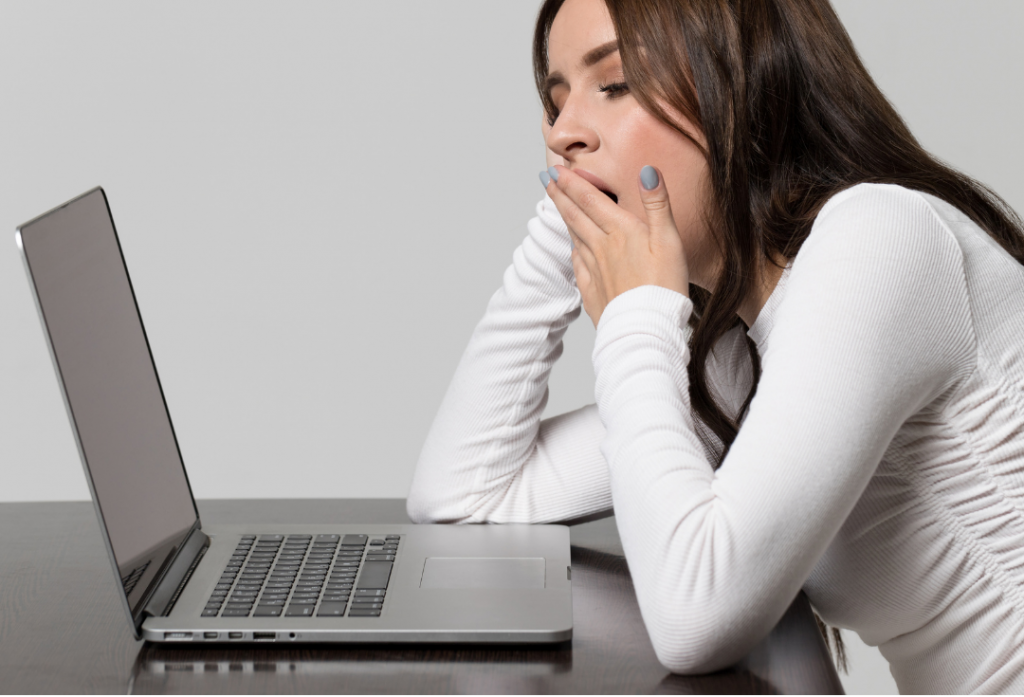It has been a year of Zooms! With Covid bringing lockdown after lockdown we have had no choice but to turn to the computer screen instead of our usual face-to-face existence (don’t we all wish we had bought shares in Zoom 2 years ago?).
It has suited some – there is, admittedly, some novelty to being able to wear track pants (or pajama pants!) to a formal work meeting. It has certainly provided extra leeway for settling in with a cup of tea or coffee during sessions. But if you have felt your energy levels being rapidly zapped after extended ‘Zooming’, you are not the only one.
Zoom fatigue is a real thing! You’d be surprised how exhausting it is to sit down and look at a screen for hours on end. We’ve experienced it personally when seeing back-to-back clients over Zoom, and our clients sometimes report feeling cognitively drained after a Zoom-based session.
We can hypothesise as to why that is – sore eyes from focusing on the screen for long periods, a sore body from extended sitting (especially in a poorly set up home office!), or the feeling of extra pressure to concentrate while you’re on video.
Regardless of the reason, we turn our focus instead towards solutions. Here are 5 tips that you can use to mitigate Zoom fatigue, as tried and tested by the Specialised Health team!
1. Movement.
We wouldn’t be exercise physiologists if we didn’t start with this, would we?
We recommend taking movement breaks between calls – to stand up, walk around, (maybe even do some squats or burpees!) – and get some blood flow around the body. Sustained upright seated positions impair blood circulation and even slow down your metabolism – both reasons leaving you feeling sluggish and tired. Interrupt the process by moving your body and we promise that you’ll feel better for it!
You can also consider whether any of your Zoom meetings would be appropriate to be taken while walking – we do this sometimes ourselves.
2. Stretch.
A close second place is stretching. Just as with all forms of movement, stretching helps to increase blood flow to the muscles, flush out the build-up of toxins and provide the muscles with a fresh supply of blood and nutrients. It also helps to lengthen the selected muscle, which may help if you are starting to feel achy or tense. A few ideas…
- If you find that you get a sore neck, try doing some shoulder circles and this stretch (hold 20 sec each side):
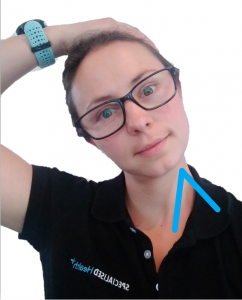
- If you get a sore upper back, try this stretch over the back of the chair (hold 10-20 seconds):
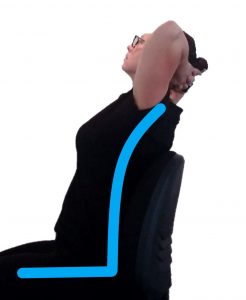
- If you get a sore lower back, try these 2 stretches (hold 20 seconds each side):
Hip flexor stretch:
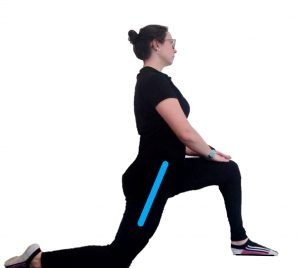
Lower back rotation stretch:
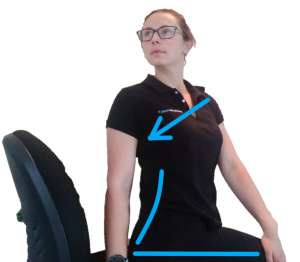
3. Look at something far away.
If you’ve spent the past few hours staring at a screen 50 cm away from your face, you shouldn’t be surprised if the feeling of tired or dry eyes starts to kick in. Take a look away from the screen for a moment. Instead, look at something in the distance to refocus your eyes to far objects instead of focusing close up.
4. Check your workstation set up.
While the first port of call is breaking up the sitting time with movement, it is equally as important to make sure your office / home office is set up with your posture in mind. Zooming from the couch with your laptop on your knees is a recipe for neck and/or backaches!
When it comes to office ergonomics, we tend to think in terms of right angles at the major joints. 90 degrees at the knees, hips and elbows. We also recommend that your chair provides some support through the curve of the lower back, and that the top third of the computer screen is at eye height. Here’s a quick guide:
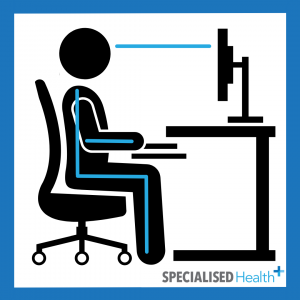
5. Separate your workspace from your home space.
When working from home it can be easy for the lines to blur between your workspace and living space, but we recommend keeping some boundaries in place! Not only does having a designated ‘work zone’ help you to stay better focussed during work hours, but it helps you to switch off more easily at the end of the day. Step away from the desk, close the office door behind you, and give yourself the much-needed time to recuperate from the day that has been. It means that the next day you’re in the office you’ll have the energy and mental space to hit the ground running again!
Zoom is here to stay, so it’s always good to have a few strategies in the back pocket for when Zoom fatigue (and those aches and pains) start to kick in! We hope that these will be helpful for you and the many Zooms to come.
Author: Yolanda van Vugt Clinical Exercise Physiologist and Content Creator at Specialised Health
Let’s connect, find us:
Have you got a claimant that would benefit from E.P. support? Refer to the team!
#exercisephysiology #exerciserehab #rehabilitation #lifeinsurance #incomeprotection #ctp #workcover #mobile #zoom #telehealth #telehealthprogram #mobileexercisephysiology #returntowork #fatigue #mentalhealth #cancer #musculoskeletal #pain #physio #physiotherapy #Sydney #Brisbane #Melbourne #Adelaide #Auckland #Waikato #BayofPlenty #Wellington #Otago #Christchurch
